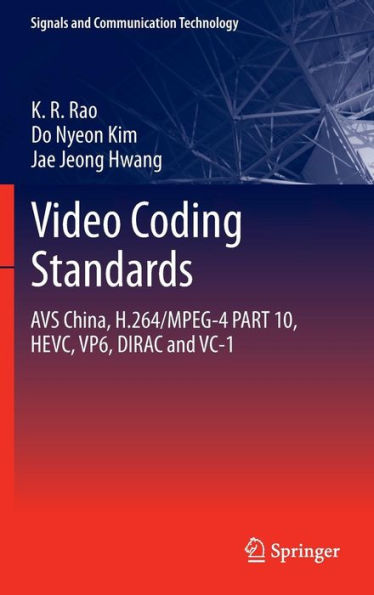
Video coding standards: AVS China, H.264/MPEG-4 PART 10, HEVC, VP6, DIRAC and VC-1
499
Video coding standards: AVS China, H.264/MPEG-4 PART 10, HEVC, VP6, DIRAC and VC-1
499Hardcover(2014)
-
SHIP THIS ITEMNot Eligible for Free ShippingPICK UP IN STORECheck Availability at Nearby Stores
Available within 2 business hours
Related collections and offers
Overview
AVS China is the abbreviation for Audio Video Coding Standard of China. This new standard includes four main technical areas, which are systems, video, audio and digital copyright management (DRM), and some supporting documents such as consistency verification. The second part of the standard known as AVS1-P2 (Video - Jizhun) was approved as the national standard of China in 2006, and several final drafts of the standard have been completed, including AVS1-P1 (System - Broadcast), AVS1-P2 (Video - Zengqiang), AVS1-P3 (Audio - Double track), AVS1-P3 (Audio - 5.1), AVS1-P7 (Mobile Video), AVS-S-P2 (Video) and AVS-S-P3 (Audio). AVS China provides a technical solution for many applications such as digital broadcasting (SDTV and HDTV), high-density storage media, Internet streaming media, and will be used in the domestic IPTV, satellite and possibly the cable TV market. Comparing with other coding standards such as H.264 AVC, the advantages of AVS video standard include similar performance, lower complexity, lower implementation cost and licensing fees. This standard has attracted great deal of attention from industries related to television, multimedia communications and even chip manufacturing from around the world. Also many well known companies have joined the AVS Group to be Full Members or Observing Members. The 163 members of AVS Group include Texas Instruments (TI) Co., Agilent Technologies Co. Ltd., Envivio Inc., NDS, Philips Research East Asia, Aisino Corporation, LG, Alcatel Shanghai Bell Co. Ltd., Nokia (China) Investment (NCIC) Co. Ltd., Sony (China) Ltd., and Toshiba (China) Co. Ltd. as well as some high level universities in China. Thus there is a pressing need from the instructors, students, and engineers for a book dealing with the topic of AVS China and its performance comparisons with similar standards such as H.264, VC-1 and RV-9.

Product Details
| ISBN-13: | 9789400767416 |
|---|---|
| Publisher: | Springer Netherlands |
| Publication date: | 10/08/2013 |
| Series: | Signals and Communication Technology |
| Edition description: | 2014 |
| Pages: | 499 |
| Product dimensions: | 6.10(w) x 9.25(h) x 0.04(d) |
About the Author
Dr. Do Nyeon Kim received the B.E. degree from Kyungpook National University, Daegu, Korea, in 1985 and the M.S. and Ph.D. degrees, both in electrical engineering, both from Yonsei University, Seoul, Korea, in 1988 and 2004, respectively. From 1989 to 1994, he was a senior researcher at ETRI, Daejeon, Korea. He was a lecturer at Yonsei University in 2004. From 2005, he is a visiting professor in the Department of Electrical Engineering, the University of Texas at Arlington. He is a recipient of IT scholarship for 2005 and 2006 for post-doctoral program from the Institute for Information Technology Advancement and the Ministry of Information and Communication, Republic of Korea. He is co-author of the book, "Fast Fourier Transform and Its Applications" (Springer, 2010).
Prof. J.J. Hwang received the B.S., M.S., and Ph.D. degrees in electronic engineering from the Chonbuk National University in 1983, 1986, and 1992, respectively. He is currently full-professor at the Kunsan National University, Korea, and adjunct professor of RMIT University, Sydney, Australia. His research interests are digital image/video coding & processing, information theory, object segmentation and tracking, and 2D/3D visual quality assessment and evaluation. He is the co-author of Techniques and standards for image, video and audio coding (Prentice Hall, 1996) and Fast Fourier transform – Algorithms and applications (Springer, 2010).Table of Contents
Preface. Acknowledgements. Abbreviations.1 Introduction.
2 Video coding standards and video formats.
3 AVS China.
4 H.264/MPEG-4 advanced video coding.
5 High efficiency video coding (HEVC).
6 VP6 video coding standard.
7 Performance analysis and comparison of the Dirac video codec with H.264/MPEG-4 Part 10.
8 The VC-1 video coding.
Appendices.
A Investigation of image quality of Dirac, H.264, and H.265 (B. Shrestha)
B PSNR average for avsnr software (G. Sullivan)
C A universal image quality index and SSIM comparison (C. Chukka)
D Performance analysis and implementation of mode dependent DCT/DST in H.264/AVC (P. Anjanappa)
E Performance analysis and comparison of JM, Intel IPP and X264 for H.264 software (S. Muniyappa)
F Implementation of AIC based on I-frame only coding in H.264 and comparison with other still frame image coding standards such as JPEG, JPEG 2000, JPEG-LS, JPEG-XR (R. Veerla)
G Higher order 2-D ICTs for HD video coding (M. Krishnan)
H Comparison of H.264 codecs
Bibliography. Index.
